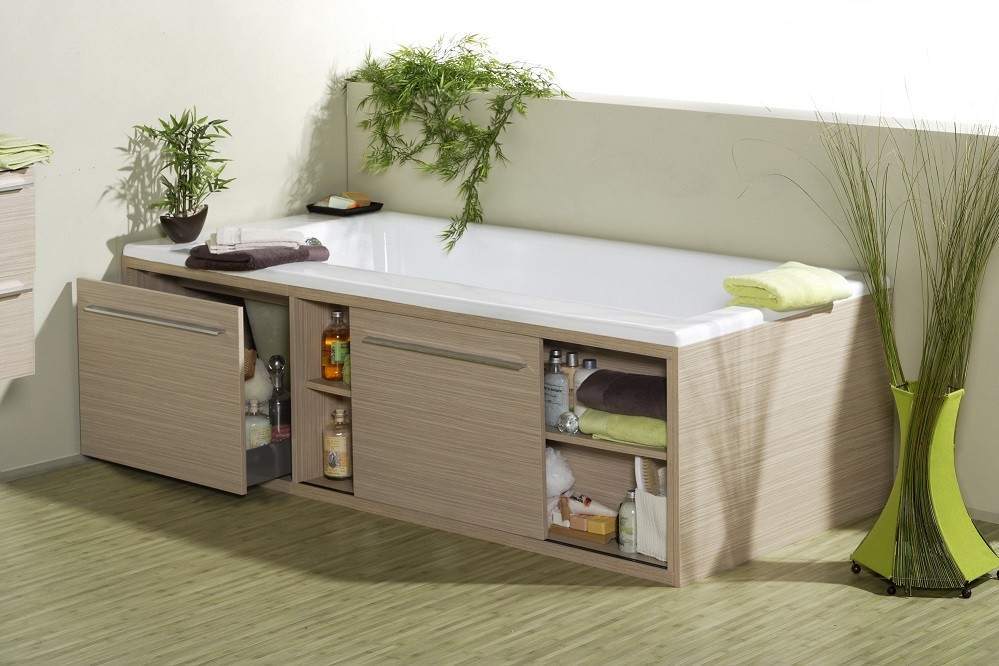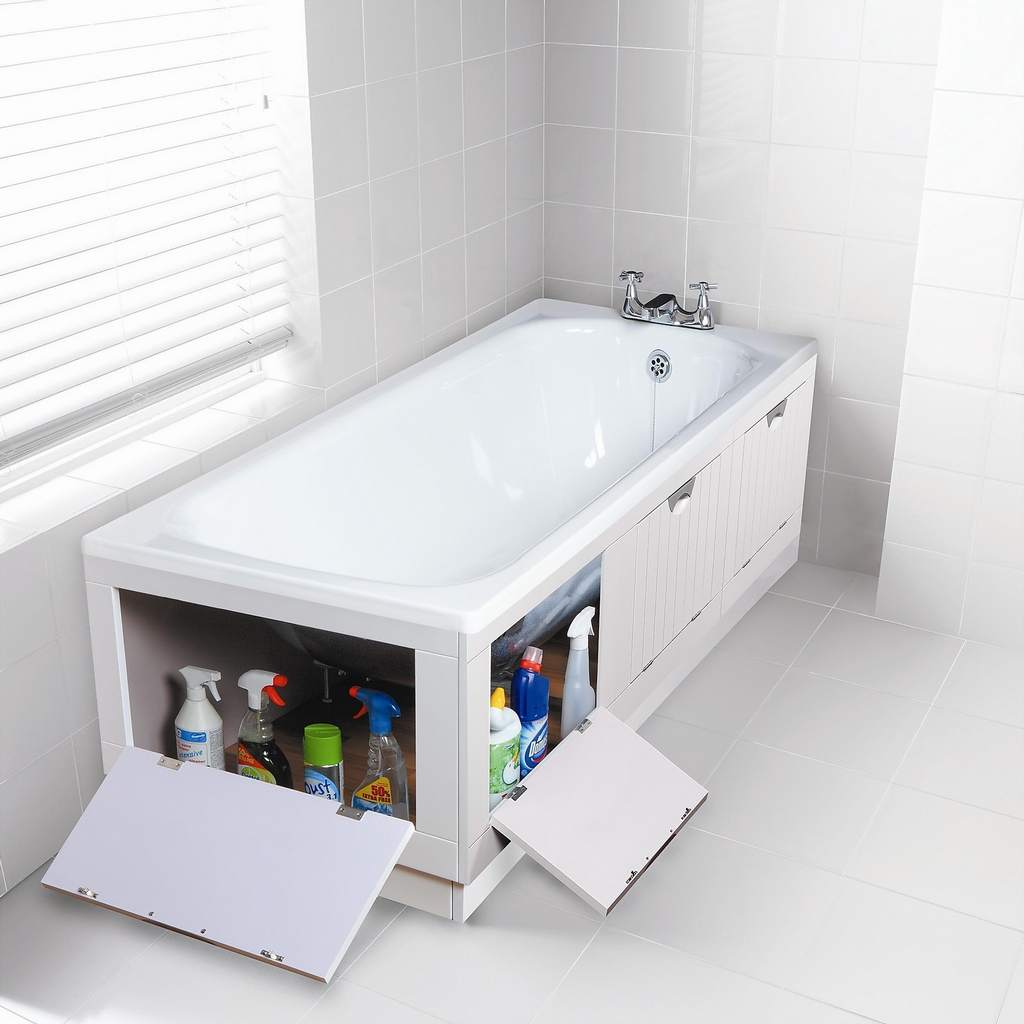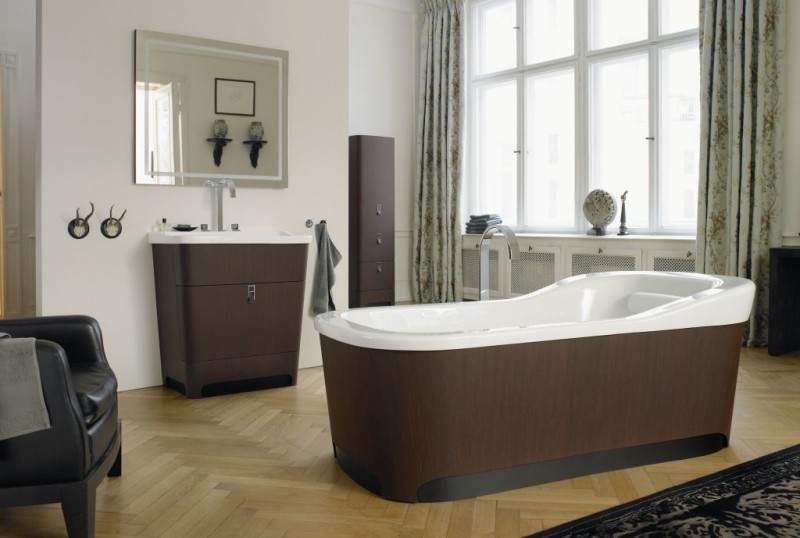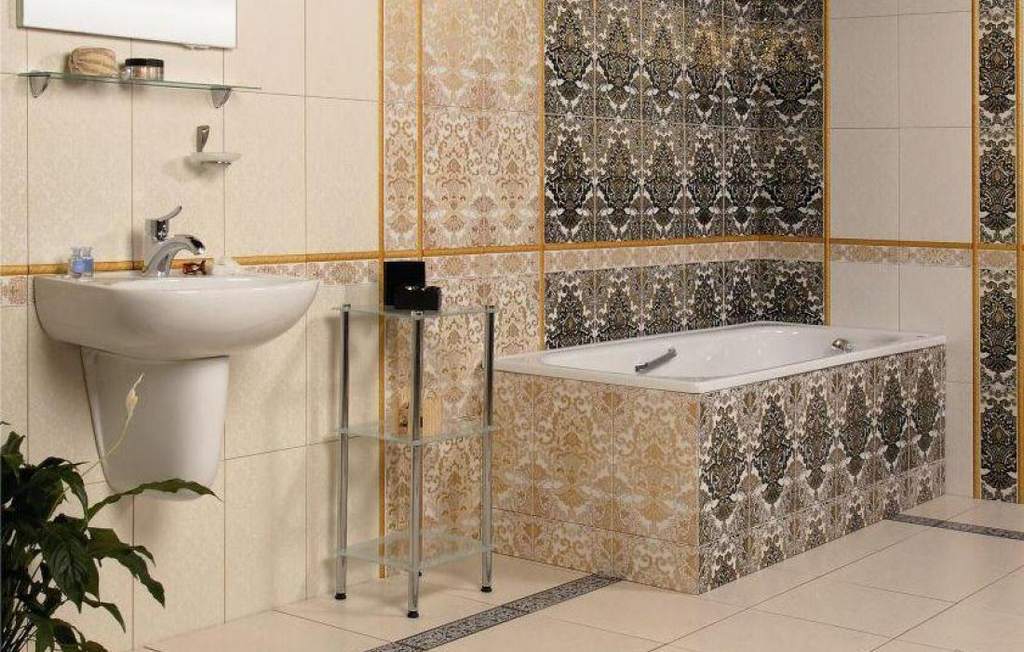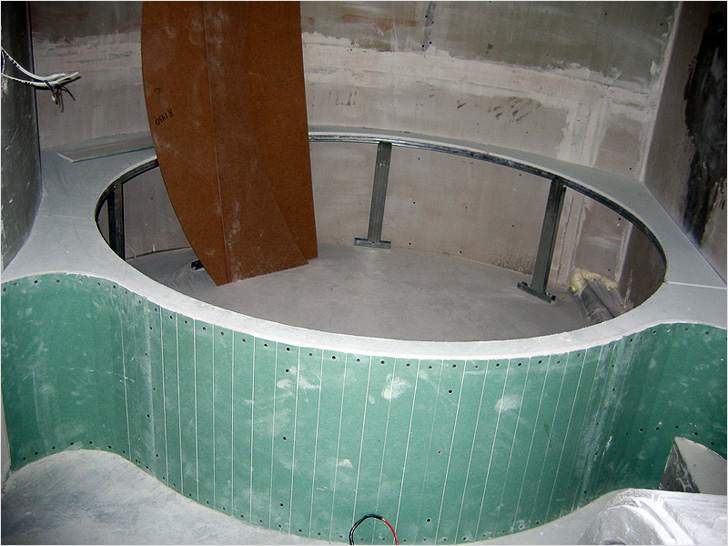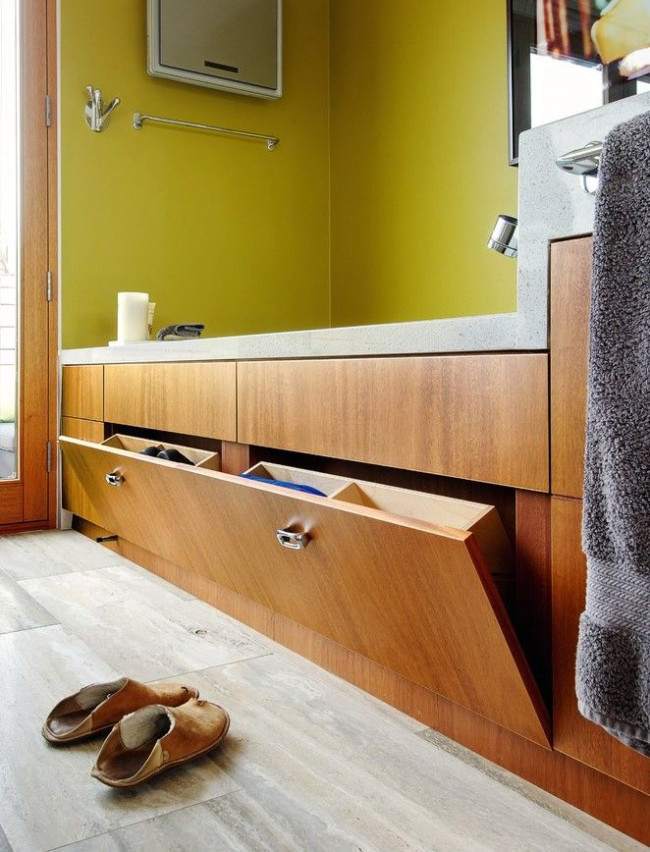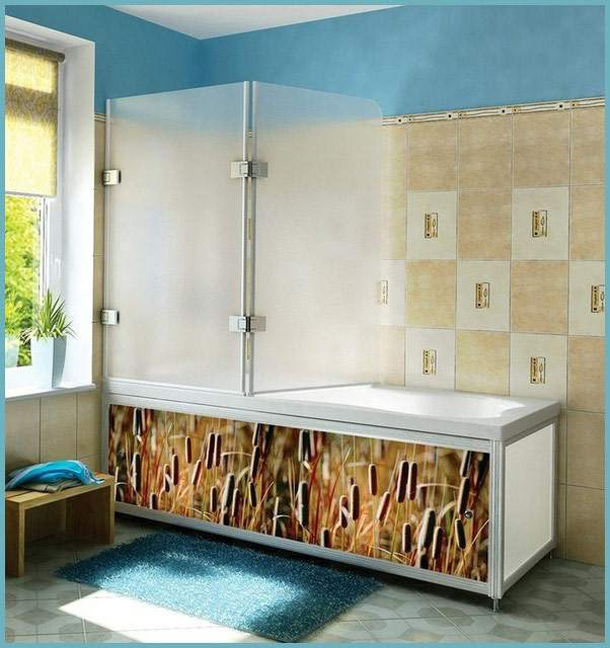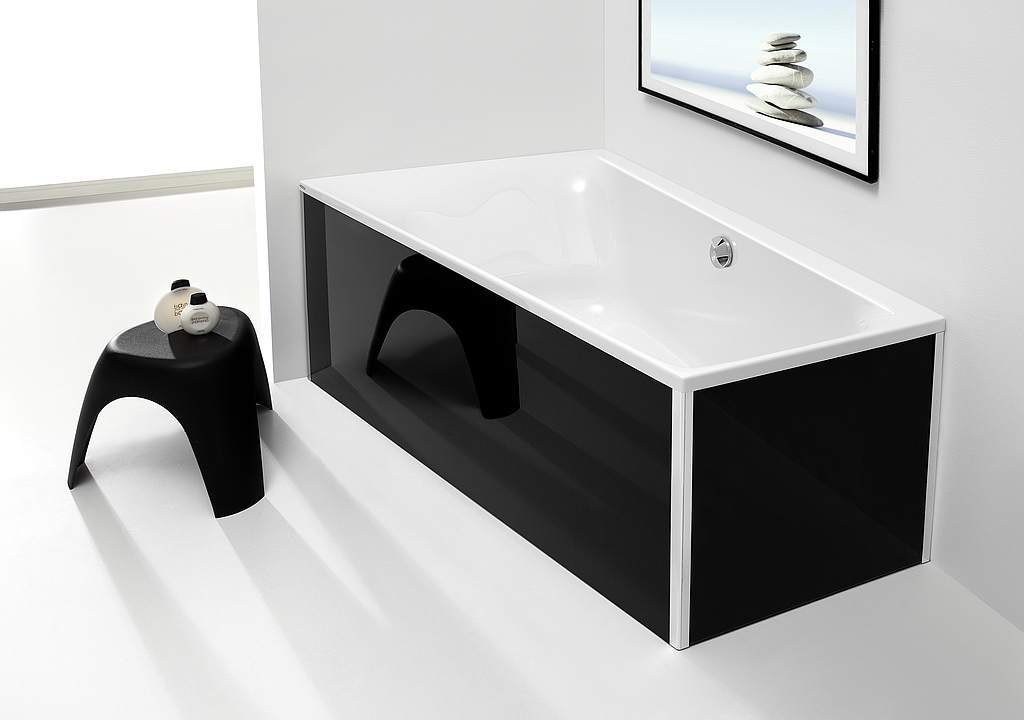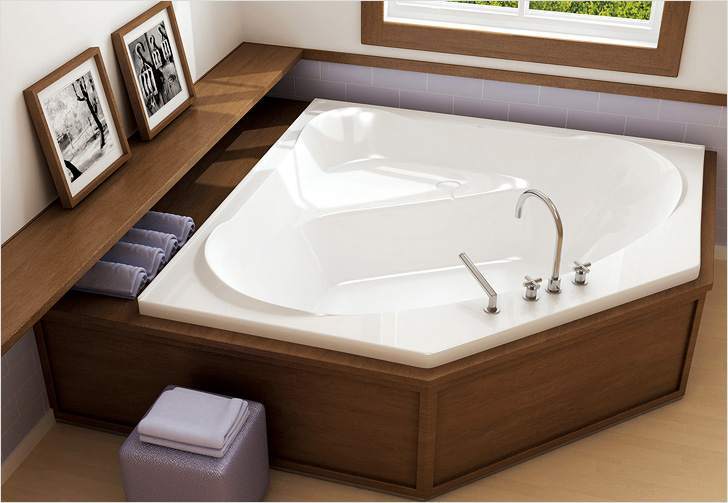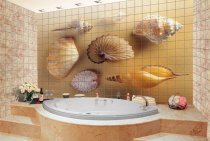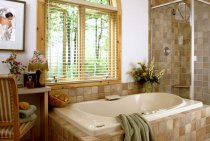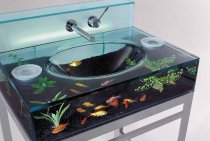Standard bathrooms are often modest in size, so some interior details perform several functions. So, bathroom screens help to close the unaesthetic view of the side walls of the bathtub, sewer communications and at the same time are an element of decor. Let's find out what these structures are, what they are made of and how to install a screen under the bath with your own hands.
Types of bathroom screens
The screen is a design that allows you to close the sides of the bath, which are in view, from the floor to the edge. It can be made from various materials and have a completely different look and configuration.
- Silent design. It is a solid canvas, makes the look of the bathroom more neat. She has one drawback - the space under the bathroom cannot be used.
- With hinged or sliding doors. The most functional type of bath screen, providing free access to the space under the bathing tank and allowing you to use it to store useful little things: cleaning products, towels, cosmetics.
- Design with shelves - a screen-locker. Usually it has a back wall, which significantly limits the size of the shelves and makes it difficult to access the sewer. Sometimes equipped with retractable trays, which gives the device additional functionality.
- Curtain made of waterproof material. A budget option, which is also often used instead of a custom-sized bath screen. The curtain is easy to make yourself from moisture-resistant textiles that match the design of the bathroom.
In addition, screens can be front and end, covering the bath from the front or side.
What type of screen is better to choose?
The advantages of a decorative panel with sliding doors for a standard rectangular bath are obvious:
- availability of finished products in stores;
- democratic price;
- simple installation;
- providing quick access to communications.
When choosing a screen with sliding or swinging out doors, as well as curtains, special attention should be paid to the material from which the fittings are made. Since plastic parts can break quickly, it is desirable that the components are made of metal, and corrosion resistant.
Important! For any types of screens, it is necessary to have an opening (technological window) that provides access to the sewer units.
A suitable screen option for a bathtub is determined depending on its type, size and shape.
Common sizes of screens for rectangular acrylic bathtubs: length - from 1.5 to 1.7 m, height - 0.5-0.56 m.
Screen materials: types, advantages and disadvantages, installation features
Bath screens can be made from different materials:
- bricks (monolithic construction);
- moisture resistant drywall;
- plastic or polycarbonate;
- moisture resistant MDF and chipboard;
- acrylic;
- tree;
- glass.
brick construction
Brick, for which finishing is required, is laid out in half-brick laying, decorated with ceramic tiles, mosaics or other materials.
Installation nuances:
- brickwork rules apply - subsequent rows are shifted by half a brick;
- a window is made near the water drain, which is closed with a special plastic door;
- a gap 2 cm high is kept under the edge of the bath, which is then sealed with mounting foam;
- in the middle of the structure, it is desirable to make a notch for the legs.
The advantage can be considered the presence of space for the design of the finish.
If the cladding is made of mirror panels, this will help to visually expand the space.
The disadvantage of the design is its fundamental nature - if a complex repair of sewer units is necessary, the brickwork will have to be dismantled. In addition, the construction process is laborious and requires professional tools and specific knowledge.
Moisture resistant drywall
For this material, as well as for brick, final finishing with tiles, plaster is required. Sheets of drywall are sewn onto a frame made of a metal profile or a wooden beam.
Mounting Features:
- self-tapping screws are selected so long as not to damage the acrylic bath;
- in order to avoid direct contact of the sheet with water on the floor from below, a gap of 1 cm must be left (between the floor covering and the lower border of the canvas);
- with the expectation of possible swelling of the material, a gap of 1 cm is left on top of the web;
- wooden beam must be treated with special compounds from the fungus, drywall - pre-primed;
- in the center of the structure, it is recommended to provide a cavity for the legs.
The main advantage is the ability to design a screen of any shape.
The disadvantage is the multi-stage work on mounting, sheathing with sheets, a relatively short service life.
MDF screen
Such structures are made from special plates covered with a protective moisture-resistant film. Installation details are the same as for plasterboard panels.
Advantages of MDF bath screens:
- affordable price;
- a variety of colors and patterns;
- ease of maintenance - wiping with a damp cloth or sponge is enough;
- a wide range of designs - a solid canvas, with hinged and sliding doors.
Serious cons:
- short service life;
- susceptibility to deformation due to the constant humid environment in the bathroom;
- do not use detergents with abrasive additives.
Plastic and polystyrene structures
Panels made of these materials are the most common and most popular design option for a bathroom screen.
Advantages:
- service life can be characterized by the expression "until you get bored";
- simplicity and convenience in the care of plastic surfaces - no special detergents are required, it is enough to wipe with a damp sponge with the addition of dishwashing liquid;
- scratch resistance;
- an incredibly extensive palette of colors and patterns;
- wealth of shapes, sizes, types;
- installation does not require special knowledge and tools;
- products are sold in almost all building supermarkets and plumbing stores.
The sequence of installation of such panels is very simple:
- the upper part of the screen is brought under the side of the bathroom;
- the panel is located vertically;
- the design is tightly fixed with adjustable legs.
Acrylic Screens
Acrylic screens most often come with bathtubs made of this material, although they can be sold separately. Typically, these screens are made of plastic coated with a layer of acrylic. They sometimes repeat the rather complex shape of an acrylic bath, close the wires at sanitary ware with hydromassage. Most often they have a recess for the legs, which allows you not to rest your feet on the panel, standing next to the bath.
glass panels
Glass for structures that cover the side walls of the bath is tempered or shockproof. A bathroom with a glass screen looks expensive and exclusive; the product can be matte, transparent, mirrored, decorated with patterns and drawings.
Wooden screens
Wooden screen will appeal to lovers of natural materials. The main condition when using wood for the manufacture of a screen is the processing of the material with a special water-repellent impregnation.
curtain screen
It is made of different materials - PVC (polyvinyl chloride), polyester, textiles with special impregnation.
Installation Features:
- fastening on a string is suitable if there is a rim near the bathroom;
- the metal frame is strongly recommended to be treated with an anti-corrosion compound;
- ready-made baguettes are completed with nuts.
Advantages:
- uncomplicated installation;
- acceptable price;
- free approach to communications;
- ease of self-production;
- scope for design solutions.
Flaws:
- a small selection of options in stores;
- textile curtains require special care - washing, for which it is necessary to provide for a simple type of disassembly of the fastening system.
Screen installation steps
Most often, the installation of a structure for a bathroom includes the following steps:
- Taking detailed measurements.
- Marking frame fasteners.
- Assembly and installation of the frame.
- Panel installation.
- Finishing work.
Please note: The tub must not rest on the screen.
As a rule, plumbing manufacturers attach appropriate installation instructions for structures made of plastic panels and other materials.
If there is no opportunity or desire to independently make and install a design for the bathroom, seek help from specialists.
